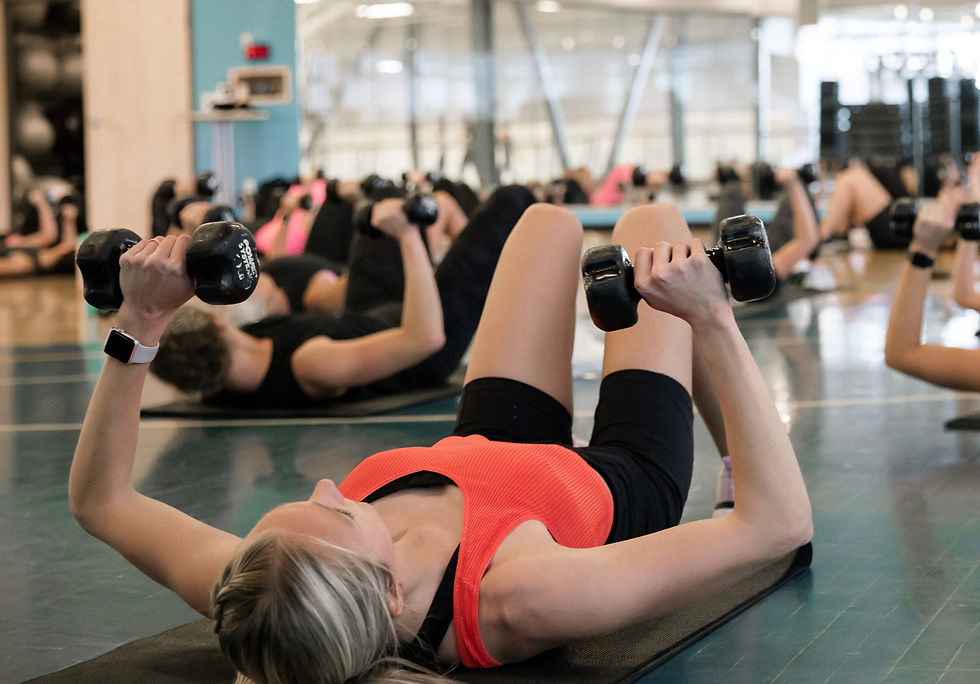Regular vs. Reverse Grip Dumbbell Chest Press: Which Builds a Better Chest?
- Ali and Tracy
- Nov 5
- 2 min read

When it comes to building a strong, sculpted chest, the dumbbell chest press is a go-to move for athletes and everyday lifters alike. But here’s a simple tweak that can completely change the way your muscles fire: flip your grip.
Switching from a regular grip (palms forward) to a reverse grip (palms facing you) might look subtle, but the shift in activation, comfort, and results is major. Here’s what you need to know.
🏋️♂️ Regular Grip Dumbbell Chest Press
The classic power press.
With your palms facing forward, the regular grip dumbbell chest press is all about building overall chest size and strength. It’s stable, familiar, and a staple in any chest workout.
✅ Muscles Worked:
Primary: Mid chest (pectoralis major)
Secondary: Front deltoids & triceps
✅ Why It Works:
This grip allows you to press heavier and train through a powerful range of motion. It recruits the big movers of the chest and arms, making it ideal for strength and size gains.
✅ How It Feels:
Strong, stable, and full-bodied. You’ll feel it primarily across the mid-chest and front shoulders.
🔄 Reverse Grip Dumbbell Chest Press
The underrated upper-chest activator.
Flipping your grip so your palms face toward you instantly changes which muscles do the work. The reverse grip press hits the upper chest harder and reduces shoulder strain.
🔥 Muscles Worked:
Primary: Upper chest (clavicular head of the pecs) & biceps
Secondary: Front delts — but with less load & triceps
🔥 Why It Works:
This underhand position enhances upper chest engagement and places less stress on the shoulder joint. It forces you to control the motion more deliberately, improving stability and coordination.
🔥 How It Feels:
A little awkward at first — but once you find your rhythm, it delivers an intense mind–muscle connection and deeper chest activation.
⚖️ Side-by-Side Comparison
Feature | Regular Grip | Reverse Grip |
Target Area | Mid chest | Upper chest |
Shoulder Involvement | Higher | Lower |
Grip Comfort | Natural, stable | Awkward at first |
Best For | Size & power | Upper chest & joint health |
Quick Summary:
➡️ Regular = strength and volume
➡️ Reverse = precision and muscle activation
🧠 When to Use Each
Use the Regular Grip when you’re focused on overall chest development or performing heavy compound sets.
Use the Reverse Grip when you want to:
Target the upper chest more directly
Reduce shoulder discomfort
Add variety and balance to your chest routine
Try alternating between them—using the reverse grip as a finisher or accessory movement—to keep your training dynamic and balanced.
⚡ The Takeaway
A small shift in hand position can make a big difference in results. The reverse grip dumbbell chest press isn’t just a variation — it’s a game-changer for upper chest activation and shoulder-friendly strength training.
💬 Join the Conversation
Have you tried the reverse grip chest press? Which one challenges you more? Try it in our TOTW "The Middle". Find a class at www.surge-fit.com/find-a-class
Share your experience in the comments — or tag us @SurgeFit to show us your form and power. 💪






Comments